Omar Najjar's thesis defence
Add to the calendarMultiscale modeling of cracking of a reinforced concrete element for the evaluation of leakage rates in severe accident situations
CFD simulation of air flow through a macro-crack generated numerically by a Brazilian splitting test at an imposed displacement of 85 μm. The figure shows (left) the pressure field along the crack walls, (middle) the air streamlines, and (right) the velocity field in the near-wall region for an inlet pressure of 1 bar.
Given the aging of concrete and the need to extend the lifespan to cover long-term operations of nuclear power plants, it is essential to have the tools needed to predict the evolution of concrete properties and the associated consequences on structural and functional performance. This work focuses on the containment of nuclear reactors and their sealing function under nominal operating conditions. Pressurization tests are carried out during the ten-yearly outage programs to assess this tightness. The internal pressure applied varies around 4 bars relative to ambient temperature. The leakage rates measured must be below well-defined regulatory thresholds to allow the Nuclear Safety Authority to extend operation.
Experimental studies such as MAEVA (Granger et al., 2001) or VERCORS (Charpin et al., 2021) have assessed the structural scale's leakage ratio through concrete porosity and cracks. These results are crucial for developing and validating simulation tools for the mechanical behavior of quasi-brittle materials (concrete) and transport in porous/fractured medium (diffusion and flow). Numerous investigations have demonstrated that various aspects of crack geometry (e.g., opening, roughness, tortuosity) influence leakage rates within the specimen scale (Akhavan et al., 2012). However, precisely characterizing the three-dimensional geometry of concrete cracks at the structural scale is still a significant challenge.
In this work, a new method is developed, integrating finite element analysis (FEA on Cast3m), discrete element modeling using the particle-beam approach (on DEAP), and computational fluid mechanics (CFD on Ansys CFX) to accurately predict the geometries of cracks in concrete and thus enable a realistic description of flows and objective quantification of leakage rates. The first stage of this method consists of carrying out a macroscopic continuous finite element analysis, the result of which is a damage map, followed in a second stage by a fine discrete model to represent cracking explicitly. In the third stage, a 3D cracking geometry is post-processed and meshed, considering a detailed description of the tortuosity, which impacts the flow rate more than the roughness. In the final stage, this crack mesh is used for a CFD model to quantify the flow rates.
The approach was applied to a Brazilian splitting test, demonstrating the tool's ability to describe the flow rate through complex crack geometries with promising results. The proposed approach was then applied to the COBRA model, a representative structure volume for the containment building, to characterize cracking. Thanks to the proposed chaining method, it was possible to predict crack patterns in reinforced concrete in terms of tortuosity and opening variations, improving the representativeness of cracks in numerical models while maintaining a reasonable computational cost. This approach can enhance the accuracy of predicting leakage rates. Furthermore, the description of the evolution of flow rates as a function of crack openings using a CFD approach is considered as a future perspective for COBRA applications.
Composition du jury :
BRIFFAUT Matthieu – Professeur des universités, École Centrale de Lille – Rapporteur
LABORDERIE Christian – Professeur des universités, ISA BTP, Université de Pau et des Pays de l’Adour – Rapporteur
MICHEL-PONNELLE Sylvie – Ingénieure-chercheuse, EDF – Examinatrice
DAL PONT Stefano – Professeur des universités, Université Grenoble Alpes – Examinateur
JASON Ludovic – Directeur de recherche HDR, CEA – Examinateur
BENBOUDJEMA Farid – Professeur des universités, ENS Paris-Saclay – Examinateur

